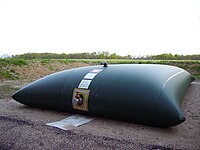
Photo from wikipedia
ABSTRACT Hinterland transportation costs constitute a significant portion of total container transport costs. However, the repositioning effects of empty containers in hinterland areas have not been studied well compared to… Click to show full abstract
ABSTRACT Hinterland transportation costs constitute a significant portion of total container transport costs. However, the repositioning effects of empty containers in hinterland areas have not been studied well compared to those in maritime areas. In addition, the effects of using foldable containers have not been investigated fully at an operational level. In this study, we analyze the effects of using a restricted number of foldable containers in hinterland areas. Mathematical models were developed to minimize total costs, and various effects of using foldable containers were investigated. To evaluate the real-world situation with the models, different customer scenarios and port policies were considered. The experiment results showed that foldable containers could notably reduce total costs. They also indicated that each effect could vary significantly depending on conditions. Therefore, the trade-offs between cost savings and additional costs incurred by using foldable containers should be contemplated in order to exploit foldable containers successfully in hinterland areas.
Journal Title: Transportation Letters
Year Published: 2019
Link to full text (if available)
Share on Social Media: Sign Up to like & get
recommendations!